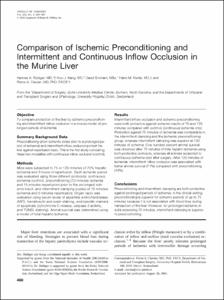Comparison of Ischemic Preconditioning and Intermittent and Continuous Inflow Occlusion in the Murine Liver
- Affiliated Author(s)
- 강구정
- Alternative Author(s)
- Kang, Koo Jeong
- Journal Title
- Annals of Surgery
- ISSN
- 0003-4932
- Issued Date
- 2002
- Abstract
- Objective
To compare protection of the liver by ischemic preconditioning
and intermittent inflow occlusion in a mouse model of prolonged
periods of ischemia.
Summary Background Data
Preconditioning (short ischemic stress prior to a prolonged period
of ischemia) and intermittent inflow occlusion protect the
liver against reperfusion injury. This is the first study comparing
these two modalities with continuous inflow occlusion (control).
Methods
Mice were subjected to 75 or 120 minutes of 70% hepatic
ischemia and 3 hours of reperfusion. Each ischemic period
was evaluated using three different protocols: continuous
ischemia (control), preconditioning (10 minutes ischemia
and 15 minutes reperfusion) prior to the prolonged ischemic
insult, and intermittent clamping (cycles of 15 minutes
ischemia and 5 minutes reperfusion). Organ injury was
evaluated using serum levels of aspartate aminotransferase
(AST), hematoxylin and eosin staining, and specific markers
of apoptosis (cytochrome C release, caspase 3 activity,
and TUNEL staining). Animal survival was determined using
a model of total hepatic ischemia.
Results
Intermittent inflow occlusion and ischemic preconditioning
were both protective against ischemic insults of 75 and 120
minutes compared with controls (continuous ischemia only).
Protection against 75 minutes of ischemia was comparable in
the intermittent clamping and the ischemic preconditioning
group, whereas intermittent clamping was superior at 120
minutes of ischemia. One hundred percent animal survival
was observed after 75 minutes of total hepatic ischemia using
both protective protocols, whereas all animals subjected to
continuous ischemia died after surgery. After 120 minutes of
ischemia, intermittent inflow occlusion was associated with
better animal survival (71%) compared with preconditioning
(14%).
Conclusions
Preconditioning and intermittent clamping are both protective
against prolonged periods of ischemia. In the clinical setting,
preconditioning is superior for ischemic periods of up to 75
minutes because it is not associated with blood loss during
transection of the liver. However, for prolonged ischemic insults
exceeding 75 minutes, intermittent clamping is superior
to preconditioning.
- Department
- Dept. of Surgery (외과학)
- Publisher
- School of Medicine
- Citation
- Hannes A. Ru¨ diger et al. (2002). Comparison of Ischemic Preconditioning and Intermittent and Continuous Inflow Occlusion in the Murine Liver. Annals of Surgery, 235(3), 400–407.
- Type
- Article
- ISSN
- 0003-4932
- Appears in Collections:
- 1. School of Medicine (의과대학) > Dept. of Surgery (외과학)
- 파일 목록
-
-
Download
 oak-aaa-00254.pdf
기타 데이터 / 563.6 kB / Adobe PDF
oak-aaa-00254.pdf
기타 데이터 / 563.6 kB / Adobe PDF
-
Items in Repository are protected by copyright, with all rights reserved, unless otherwise indicated.